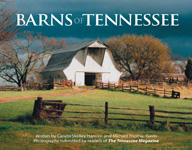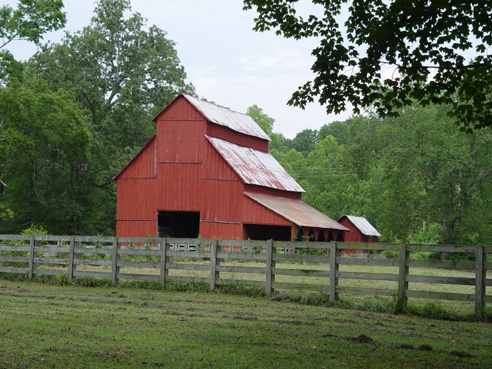MTSU’s Caneta S. Hankins and Michael T. Gavin have teamed with Donning Company Publishers, the staff of The Tennessee Magazine, to create “Barns of Tennessee,” which illustrates the indelible connection between generations of the state’s residents and their farms.
 The 160-page, hardbound title features 375 photographs of Tennessee barns—made from stone, log, brick and metal—along with information about each one. Most of the photographs are in color, though several are vintage black-and-white images.
The 160-page, hardbound title features 375 photographs of Tennessee barns—made from stone, log, brick and metal—along with information about each one. Most of the photographs are in color, though several are vintage black-and-white images.
In working to make the book project a reality, authors Hankins, assistant director of the Center for Historic Preservation at MTSU, and Gavin, preservation specialist for the Tennessee Civil War National Heritage Area, sorted through more than 3,500 photos. The project began with a request to readers of The Tennessee Magazine to share photographs and stories of their barns.
“The overwhelming response of Tennesseans to this invitation indicates the significance of farming not only to our history but, more importantly, to the current contributions of farms and farmers to the state’s overall economy and to a safe and reasonably priced local source of food,” Hankins shared.
At the start of the project, she added, “We had about 25 banker’s boxes of photographs to go through . . . and we made sure we had at least one barn from each of Tennessee’s counties.”
Co-author Gavin, meanwhile, recalled that, “After looking through the images and descriptions that people submitted, it was obvious that Tennesseans love their barns. Our challenge was to organize the abundance of material in a way that was meaningful and understandable.”
The limited-edition pictorial book and the overall collection of photographs is an invaluable documentation of the Tennessee farms and barns that, for more than two centuries, have shaped the agrarian landscape and culture of the state, observed Dr. Carroll Van West, director of MTSU’s Center for Historic Preservation.

A barn at Rutledge Falls in Coffee County dates to the 1920s.Photograph by S. Dean Northcutt.
The book’s production team included The Tennessee Magazine staffers Robin Conover, Chris Kirk and Jerry Kirk, with Trish Milburn editing the book and Ron Bell serving as designer. Photographs from the collection of Conover, editor of The Tennessee Magazine, are also included.
“The barns that are spread across the landscape have played a pivotal role in the changes and continuity of Tennessee’s farming traditions for more than 200 years,” noted Hankins, who also oversees the Tennessee Century Farms program via her work through CHP.
“The Barns of Tennessee,” which is available at tnelectric.org, also includes historic reference information about each barn, as well as architectural types of barns and their functions in the agrarian lifestyles of Tennessee’s farmers.
“Because barns are the symbol of farming, ways to maintain and use them in a changing culture and landscape are also part of the book,” Hankins said. “Each community, county and the state as a whole must seriously and intentionally ask hard questions about the future of farms, especially family farms, which are vital to our very survival.”













